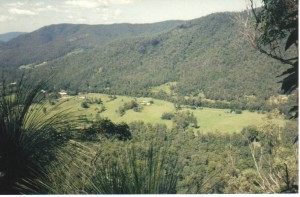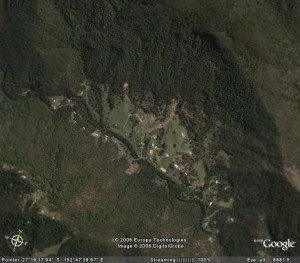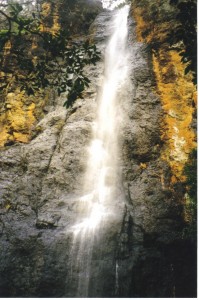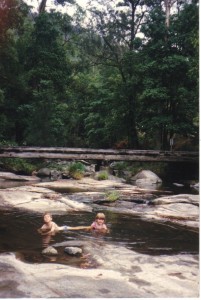As I have written elsewhere, knowing the country used for the setting of a novel through personal experience is of immense value to an author. In my present work, a sequel to Turrwan, I needed a secluded hideaway for the villains and realised that the property I had lived on for seven years was perfect as a starting point. The following is a piece I wrote for a university course and which I have subsequently adapted and used in the first draft of the novel.
Just 30 km from the centre of Brisbane, Cedar Creek winds its way to flatter lands after cascading down through the rain-forested slopes of Mt Glorious. The gorge opens out onto a secluded valley surrounded on all sides by mountains (Glorious, D’Aguilar, Samson, Lawson). The  creek clings tightly to the flanks of Mt Glorious on one side while the northern side opens to more gently undulating lands before rising steeply to the rock escarpments south of Mt Samson. Away from the creek the trees have been cleared and kikuyu grass planted for dairy cattle. The verdant meadows laze peacefully in the sun, while contented cattle chew their cud in the shade of the bushy wattles that hedge the fields before tallowwoods and blue gums take over, lining the gullies and ridges with hues of green. Huge megalithic granite boulders hide amongst the vines, and further up the slopes lantana lurks in the shadows, impenetrable.
creek clings tightly to the flanks of Mt Glorious on one side while the northern side opens to more gently undulating lands before rising steeply to the rock escarpments south of Mt Samson. Away from the creek the trees have been cleared and kikuyu grass planted for dairy cattle. The verdant meadows laze peacefully in the sun, while contented cattle chew their cud in the shade of the bushy wattles that hedge the fields before tallowwoods and blue gums take over, lining the gullies and ridges with hues of green. Huge megalithic granite boulders hide amongst the vines, and further up the slopes lantana lurks in the shadows, impenetrable.
 This special place was my home for seven years. Like a bowl, it collects the summer rains that fall on the mountains and is therefore greener than lower areas. The mountains also cast wide shadows across the valley keeping temperatures a few degrees cooler than Brisbane. You can feel a sense of protection in a womb-like embrace, the power of the place is almost tangible, you can taste it in the twinkling pool, smell it in the yellow wattle, you hear it in the screech of the white cockatoos and the busy chattering of multi-coloured parrots. When it rains the clouds blanket the landscape, so close you can almost touch them as the mists rise with the heat.
This special place was my home for seven years. Like a bowl, it collects the summer rains that fall on the mountains and is therefore greener than lower areas. The mountains also cast wide shadows across the valley keeping temperatures a few degrees cooler than Brisbane. You can feel a sense of protection in a womb-like embrace, the power of the place is almost tangible, you can taste it in the twinkling pool, smell it in the yellow wattle, you hear it in the screech of the white cockatoos and the busy chattering of multi-coloured parrots. When it rains the clouds blanket the landscape, so close you can almost touch them as the mists rise with the heat.
The creek is named for the magnificent red cedars (Toona australis) that once abounded. Unfortunately, many fell victim to the demand for the quality timber much appreciated by furniture makers. An old disused sawmill, nestled beside the creek where it first enters the valley, remains as a witness to their passing. The red cedar is one of the few native Australian species that lose their leaves in winter. The vigorous growth of spring-green leaves are a delight to behold, you can almost feel the life force pulsing within.
Cedar Creek is a measure of the climate and the physical features  of the area. One year it never stopped raining – the earth was literally weeping, spilling giant tears into the creek. The locals say it used to flood just about every year, and it certainly never stopped running for months on end as is the case these days. Rare are the times now that you hear the boulders rumbling and crunching in the roar of the flood that can drown the unwary in the turbulent, mud-brown flow. In a tragic accident not long after we moved to the valley, a 14 year old girl trying to save her dog fell into the swiftly flowing waters and drowned. I remember an earlier time helping our kids across the same causeway with the help of a rope. The power of the water was incredible.
of the area. One year it never stopped raining – the earth was literally weeping, spilling giant tears into the creek. The locals say it used to flood just about every year, and it certainly never stopped running for months on end as is the case these days. Rare are the times now that you hear the boulders rumbling and crunching in the roar of the flood that can drown the unwary in the turbulent, mud-brown flow. In a tragic accident not long after we moved to the valley, a 14 year old girl trying to save her dog fell into the swiftly flowing waters and drowned. I remember an earlier time helping our kids across the same causeway with the help of a rope. The power of the water was incredible.
Over time the creek has carved its way down to a rocky bottom with deep holes, waterfalls and rapids alternating along its length. The water is always cool and refreshing in the heavy summer heat, and the creek is a popular picnic spot. Shady trees cling precariously to whatever their roots can find and somehow resist the regular pounding of the flood; at their feet, reeds and grasses grow amongst the sand and stones. Light filters through the overhead branches and dances in the bubbling cascades. And if you’re quiet at dawn or dusk you may be lucky enough to catch a glimpse of the shy platypus. Tiny fish dart in the shadow of a sunken log while the cicadas thrum, ever present in the background.
As with els ewhere, the inevitable development came with its roads, fences and houses popping up on the landscape. Now the noises of the surrounding bush are often pierced by a passing car or the iconic mower as progress enters the valley. The property I lived on has now been carved up into two hectare lots and is no longer recognisable as a dairy farm. I have since moved further down the creek (outside the bowl) to a house on a hill overlooking the valley. My connection to the creek is still strong, albeit different. I don’t spend as much time actually in the creek or along its banks as before. I suppose it’s because the kids have grown up – they were always wanting to go for a swim, so I had to go with them – and where I now live the creek is less accessible.
ewhere, the inevitable development came with its roads, fences and houses popping up on the landscape. Now the noises of the surrounding bush are often pierced by a passing car or the iconic mower as progress enters the valley. The property I lived on has now been carved up into two hectare lots and is no longer recognisable as a dairy farm. I have since moved further down the creek (outside the bowl) to a house on a hill overlooking the valley. My connection to the creek is still strong, albeit different. I don’t spend as much time actually in the creek or along its banks as before. I suppose it’s because the kids have grown up – they were always wanting to go for a swim, so I had to go with them – and where I now live the creek is less accessible.
Cedar Creek has been a part of my life for the last 18 years. Even if I move away from this area, it will always remain as the defining element of those years. I count myself lucky to have had this opportunity to get to know such a beautiful area.
